When you get started with your B2B campaign, you’ll be excited to get the ball rolling. After all, you’ve been waiting for this moment for a long time.
An effective lead generation campaign can help boost sales, grow your business more quickly, and shorten the time it takes to see returns on your investment. But today’s B2B buyers are more informed and sophisticated than ever before.
- What Is Lead Qualification?
- How Does Lead Qualification Work?
- Why Do You Need a Lead Qualification?
- Why Is Lead Qualification Important?
- 1. Focus Your Sales And Marketing Efforts On The Most Promising Leads
- 2. Allocate Your Resources More Efficiently By Identifying Which Leads Can Convert
- 3. Improve Your Win Rate By Targeting The Right Prospects
- 4. Shorten Your Sales Cycle By Identifying Which Leads Are Ready to Buy
- 5. Improve Your Customer Lifetime Value By Helping You Target Potential Long-Term Customers
- 6. Increase Your Return On Investment By Focusing Your Efforts In The Right Direction
- Qualified Leads vs. Unqualified Leads
- Lead Qualification Frameworks
- BANT
- ChAMP
- ANUM
- MEDDPICC
- GPCTBA/C&I
- MINDA
- Lead Qualification Checklist
- How to Qualify Leads with Dripify?
- 1. Research
- 2. Outreach
- 3. Qualification
Imagine sending out emails and messages to a potential lead that shows no interest in your business. You hope they’ll enter the next stage of your sales cycle, but they keep you hanging. If only there were ways to pinpoint qualified leads. Sigh!
Determining which leads are qualified and ready to move forward is one of the most challenging yet crucial parts of the sales process. If you don’t qualify your leads effectively, you risk wasting time and resources on leads that won’t convert. The stakes are high in B2B lead qualification!
The tricky part is that it’s tough to know which leads are worth your time and resources. You don’t want to miss out on potential customers, but you also don’t want to spend all day talking to people who aren’t interested in what you have to offer. Luckily, it doesn’t have to be that way forever because Dripify can help you do effective lead qualification.
To determine whether a lead is worth pursuing, you need to collect information about their needs and interests and launch an outreach campaign to find qualified leads. That’s where Dripify can save the day for you! But how exactly can Dripify sales automation software help you with the lead qualification process?
In this comprehensive guide, we’ll walk you through everything you want to know about lead qualification with Dripify. Whether you want to understand sales qualified lead frameworks or need an actionable strategy to qualify them, this guide has you covered. Keep reading!
What Is Lead Qualification?
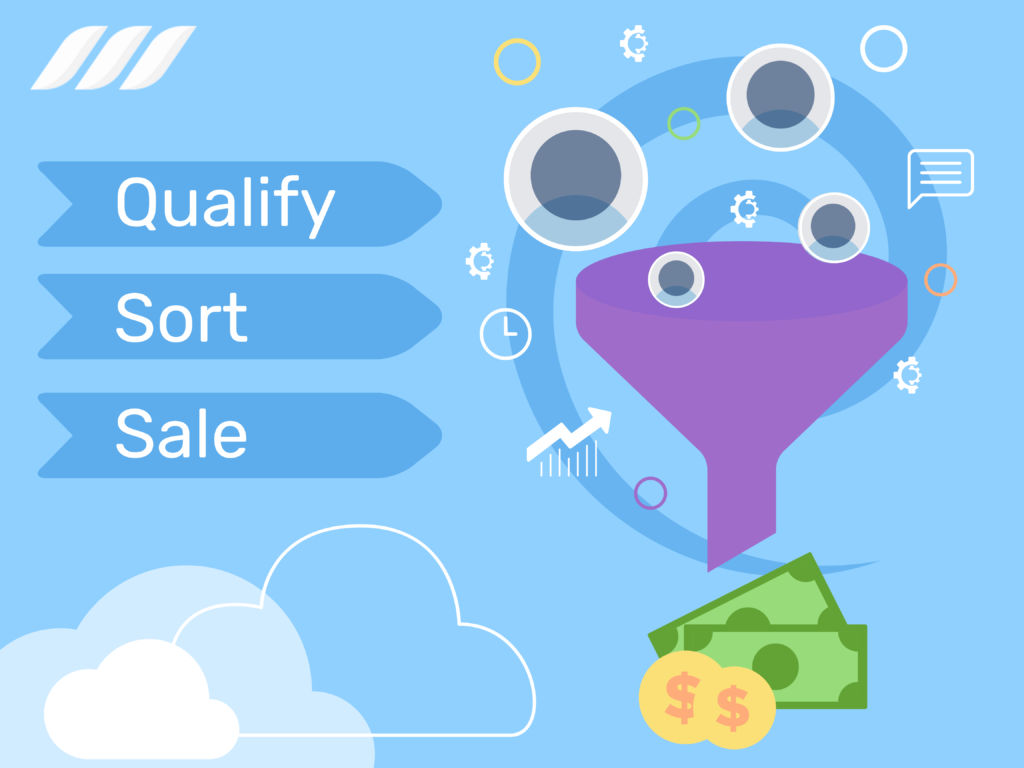
Lead qualification refers to the process of qualifying and sorting potential customers before initiating the sales process. Qualifying leads allows you to determine if there is an opportunity worth pursuing before investing your time, energy, and limited resources in them. The secret to successful lead qualification is understanding what data you need and where to collect the data from.
Businesses must engage in lead qualification to determine whether or not a potential customer will convert. It is also a stage where you gather information about a lead to see if they are a good fit for your products or services. This process usually involves researching the lead’s background, needs, and problems.
For example, if you sell a SaaS product, you can qualify a lead by asking questions about the size of their business and what kind of software they currently use. If you feel your offering will solve a problem for their business, it means you’ve found a marketing qualified lead.
In the next step, you can start sending them your marketing material, curate an offer they can’t resist, and pursue them until you see them taking your desired action, such as purchasing your software. Lead qualification allows you to save time and resources because you invest your efforts, time, and resources on leads that are more likely to convert.
While multiple factors go into lead qualification, the most important one is FIT. In other words, does the potential customer have a need or problem that your product or service can solve? If the answer is no, then there’s no point in trying to sell to them.
But, if they seem a good fit for your offer, your next task is to assess their budget. Can they afford your product or service? If not, then again, there’s no point trying to sell them something they can’t purchase.
Lastly, you must assess their level of interest in your business before moving forward with your marketing efforts. Are they actively trying to find a solution to their problem? If not, you’re probably wasting your time on these prospects.
However, if they are interested and willing to avail your deal, you’ve got a good chance of making a sale. In short, lead qualification is all about assessing these three critical factors to determine whether a potential customer is worth pursuing.
How Does Lead Qualification Work?
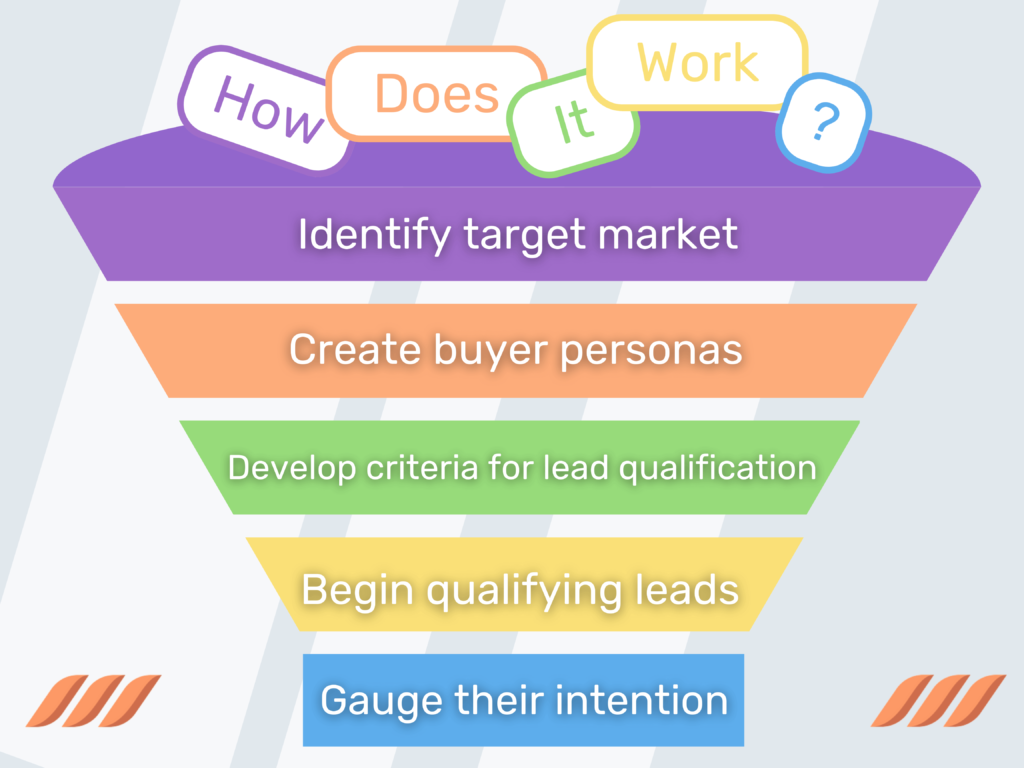
When companies do lead qualification, they’re basically figuring out if a prospective customer is worth pursuing. To do this, they consider factors like budget, authority, need, and timeline (BANT – the oldest and most widely used qualification criteria).
For example, imagine you want to sell software that costs $5,000 per year. And let’s say you find someone interested in your product, but their budget is only $500 per year. This means they aren’t your qualified lead. On the other hand, if you’re talking to an interested lead with a budget of $10,000 per year for software, you’ve found a qualified lead.
The lead qualification process usually starts with identifying a target market where you want to promote your service/product. Once your target market is identified, you can create buyer personas, as these will help you identify the specific characteristics of ideal customers.
Second, you’ll develop criteria for lead qualification. This criterion will vary depending on the products or services you’re offering. The standard criteria for lead qualification include budget, need, and timeline.
Once the requirements have been established, you can begin qualifying leads and gauge their intention. This whole lead qualification process can be time-consuming and resource-intensive, but ensuring you only pursue high-quality leads is essential.
Why Do You Need a Lead Qualification?
When you’re running a business, spending your time and resources on the right leads is crucial – people who are actually interested in what you’re selling. That’s where lead qualification comes in. It helps you pinpoint whether or not a lead is worth pursuing.
The process involves assessing things like a lead’s budget, their timeline, and whether or not they have the authority to make a purchase. By qualifying leads upfront, you can save yourself a lot of time and effort down the line.
Of course, every business is different, so there’s no one-size-fits-all approach to lead qualification. But, there are a few general best practices that you can keep in mind. For starters, it’s important to clearly understand your ideal customer. Their budget? Their timeline? Do they have the authority to make buying decisions?
Once you understand your ideal customer well, you can develop criteria for qualifying (and disqualifying) leads. Additionally, you should establish communication channels with your sales team; this will ensure that your leads are properly qualified.
Lead qualification process may seem time-consuming, but it’s worth it! Working with a sales qualified lead is a lot easier and more rewarding than wasting your resources on an unqualified lead.
Why Is Lead Qualification Important?
Many think that all they need to do is generate a lot of leads and then figure out which ones are good later on. However, if you don’t qualify your leads properly, you’re wasting your time and money on prospects who may never become customers. To help you avoid this pitfall, we’ll now explore why lead qualification is so important and how you can do it effectively.
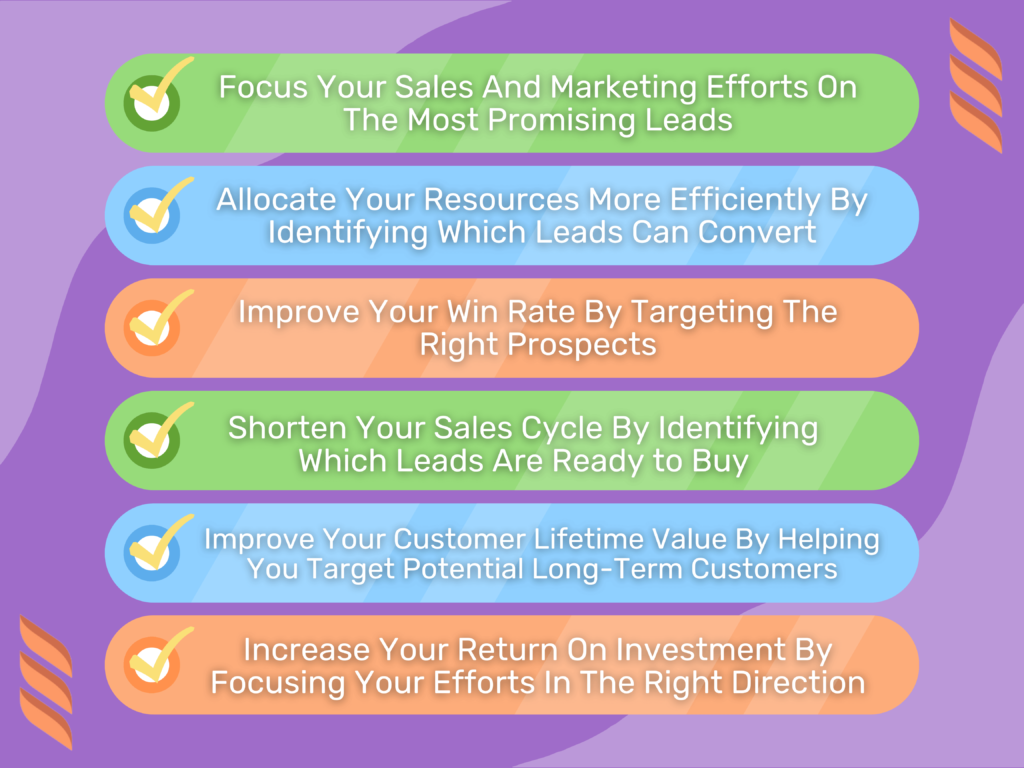
Here’re some reasons why lead qualification is crucial for your business:
1. Focus Your Sales And Marketing Efforts On The Most Promising Leads
A good lead qualification system lets you focus your sales and marketing efforts on the most promising leads. After finding the key characteristics of your ideal customer, you can prioritize leads that best match your products or services.
For example, if you sell products only available in certain countries, you can use the lead qualification to disqualify leads from countries where your products are unavailable. This ensures that you only spend time and resources pursuing a marketing-qualified lead that has a high likelihood of becoming a customer.
In addition, by understanding the needs and desires of your ideal customer, you can tailor your marketing messages to meet their preferences and significantly increase the chances of making a sale, something you might not experience while sending standard messaging to all leads.
2. Allocate Your Resources More Efficiently By Identifying Which Leads Can Convert
Being efficient with your time and resources is inevitable to the existence and growth of your business. By taking the time to assess which leads have a higher potential of converting into paying customers, you can focus your efforts on those leads rather than wasting time on leads that are less likely to result in a sale.
Let’s say you’re a wedding photographer in Alberta. A lead inquiring about wedding photography services near you for their upcoming wedding is probably a stronger lead than someone just looking for general information about photography. As a result, you would want to allocate your time and resources accordingly.
3. Improve Your Win Rate By Targeting The Right Prospects
The lead qualification process gives you enough market insights to target the right prospects with the right message at the right time. By qualifying prospects, you can increase your win rate by ensuring that you only pursue opportunities likely to result in a sale.
Let’s suppose you are a salesperson for a company that sells software. If you were to contact every single person who visited your website, you would quickly become overwhelmed and unable to sell your product effectively.
On the flip side, if you do lead qualification to identify potential customers who need your software and are ready to buy, you can focus your efforts on those individuals and close more sales. Approaching qualified leads is essential for any salesperson looking to increase their success rate, especially when you’re in a competitive market.
4. Shorten Your Sales Cycle By Identifying Which Leads Are Ready to Buy
Once you’ve generated a list of leads, qualifying them before reaching them with your sales offer is important. You can do this through multiple methods, such as asking questions or conducting research.
Qualifying leads can save a lot of time and energy, as it allows you to focus your efforts on those who are actually interested in buying. Say you’re a real estate agent. You surely wouldn’t want to waste your time showing properties to someone not interested in buying, right? That’s where lead qualification with Dripify can help you avoid and shorten your customer acquisition cycle.
5. Improve Your Customer Lifetime Value By Helping You Target Potential Long-Term Customers
Determining whether a lead is worth your time and resources are critical for your business. A few key indicators help you find a marketing-qualified lead.
For starters, look at the engagement level of the lead. Are they actively interested in your product or service? Do they respond to your emails and phone calls? If not, they may not be ready to buy, and it’s probably best to move on.
Another important factor is budget. If a lead doesn’t have the budget for your product, there’s no point in trying to sell to them.
Finally, consider the timeline. Some leads may be ready to buy right away, while others may need more time to decide. By qualifying your leads upfront, you can avoid wasting time and resources on short-term leads that are unlikely to convert.
6. Increase Your Return On Investment By Focusing Your Efforts In The Right Direction
Let’s say you’re a sales rep looking for new leads to reach out to. You could just open up your phonebook and start calling people randomly, but chances are you’re not going to have much success that way.
A better approach would be to use the lead qualification process to narrow your list of potential customers and approach them with your marketing message. Taking the time to qualify your leads lets you focus your efforts on the prospects most likely to result in a sale, which means better ROI for your business.
Qualified Leads vs. Unqualified Leads
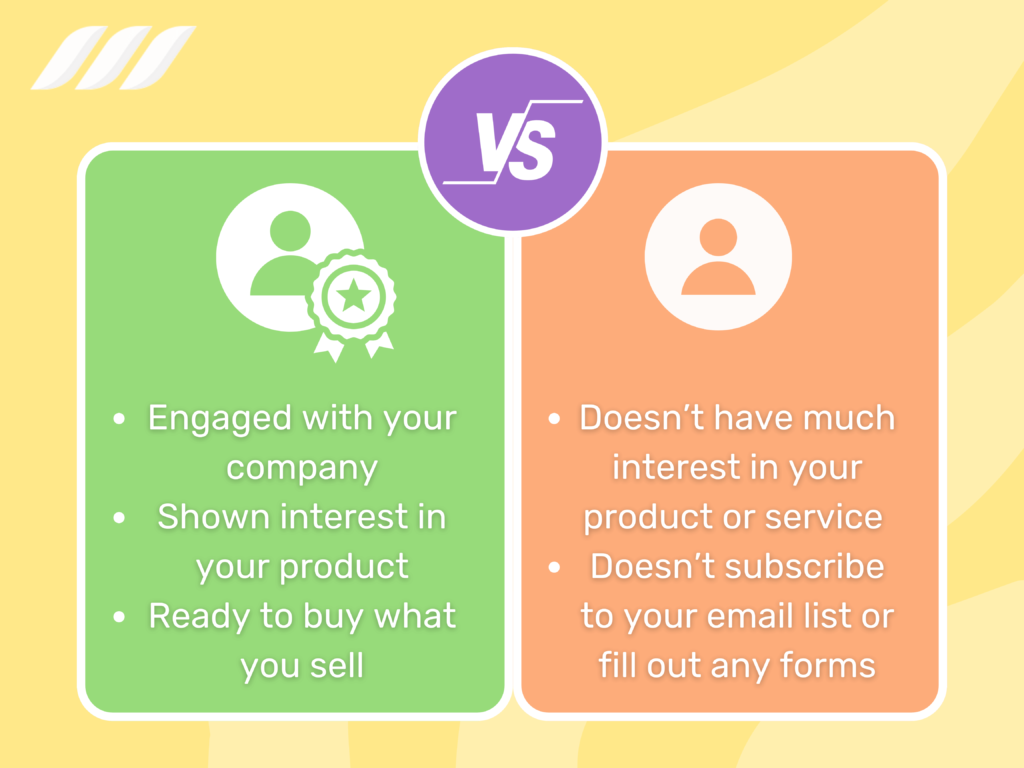
A qualified lead is a potential customer who has been engaged with your company and has shown interest in your product or service. For example, someone who fills out a form on your website or subscribes to your email list is a qualified lead and is most probably ready to buy what you sell.
On the other hand, an unqualified lead doesn’t have much interest in your product or service. When a potential customer visits your website but doesn’t subscribe to your email list or fill out any forms is an unqualified lead and has a long way to go till they do business with you.
Now it’s up to you to determine how you want to pursue these two lead types and how long they take to do business with you. The main difference between qualified and unqualified leads is that qualified leads are more likely to convert into customers, while unqualified leads are less likely to do so. That’s why you must focus on generating qualified leads when marketing your business to have better ROI and more revenue.
Lead Qualification Frameworks
When it comes to lead qualification, a few popular frameworks reign supreme. You must know these frameworks as they’re critical to optimizing your sales process and closing more deals by spending your resources on qualified leads. That’s why we’ll now take a closer look at these frameworks and explain why they’re vital for your business.
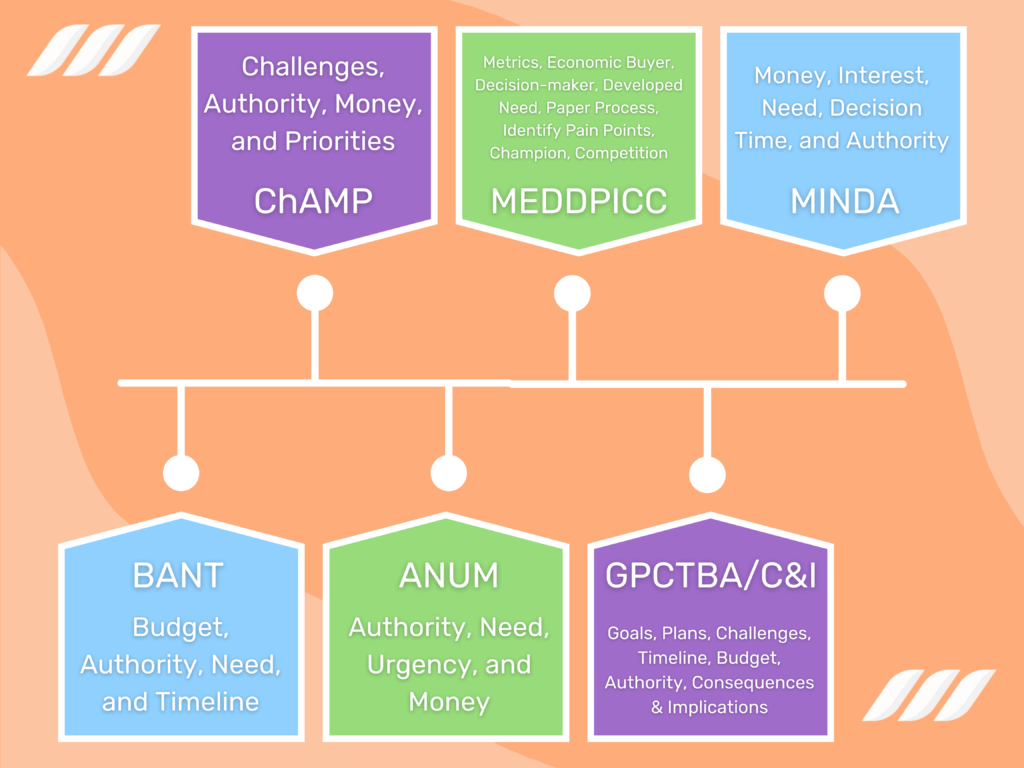
BANT
The BANT lead qualification framework is a popular system for categorizing and qualifying leads. It helps salespeople determine whether a lead is worth pursuing and, if so, how much effort should be expended.
The acronym BANT stands for Budget, Authority, Need, and Timeline. Each factor is given a score, and the lead is only considered qualified if it meets certain threshold values.
For example, a lead might need to have an established budget to be considered qualified. If a lead meets all of the criteria in the BANT for sales framework, it is said to be a “hot” lead and should be pursued with urgency.
However, if a lead does not meet all of the criteria, it is said to be “cold” and should be given less priority. The BANT qualification framework is a straightforward system that helps salespeople ensure that they are focusing their efforts on the most promising leads.
ChAMP
Most people in the business world are familiar with the acronym ChAMP, which is specifically used in lead qualification. The ChAMP lead qualification framework is a tool that helps businesses to identify and assess the potential of leads. It stands for Challenges, Authority, Money, and Priorities.
In other words, when you’re trying to qualify a lead, you need to understand their challenges, know who has the authority to make decisions within their organization, whether they have the budget to implement your solution and their priority areas.
By understanding the critical characteristics of a good lead, businesses can nurture and convert them into customers more effectively. The framework comprises four key dimensions: volume, engagement, stage in the buyer’s journey, and budget.
By assessing leads against these criteria, you can prioritize and allocate your resources more effectively. For example, a lead actively engaged with your brand at the awareness stage is more likely to convert than a lead that is merely passively interested. Similarly, a lead with a high budget is more likely to convert than one with a lower budget.
ChAMP can be used for both cold and warm leads. To qualify a lead with the ChAMP model, your leads need to be interested in your product or service and also have the budget and authority to make a purchase.
This is a good framework for qualifying leads because it’s easy to remember and covers all the bases. Plus, the ChAMP framework helps you filter out those who aren’t interested or don’t have the ability to make a purchase. By using the ChAMP lead qualification framework, you can enhance your chances of converting leads into customers.
ANUM
The ANUM framework was developed by HubSpot. It stands for Authority, Need, Urgency, and Money. This framework is designed to help sales reps quickly identify leads that are worth pursuing.
Here’s how it works: First, a sales rep assesses the authority of the lead, which means determining whether the lead is in a position to make decisions within the organization. If the answer is yes, then your lead moves on to the next step of the process.
Next, the sales rep assesses the need of the lead, which includes determining whether the lead needs the product or service being offered. If it does, the lead moves on to the next step of the sales cycle.
Now, the sales rep understands the urgency on the part of the lead. If there is no sense of urgency, then it is unlikely that the lead will convert into a customer.
Last comes the money factor, which means checking if a lead has the budget available to purchase your product or service. If the answer is yes, you have a qualified lead! If not, then you’ll need to move on to another lead.
MEDDPICC
The MEDDPICC framework is a systematic way to qualify leads.
METRICs: These are factors like industry, company size, decision maker, and pain level that will help you determine whether or not a lead is worth pursuing.
Economic Buyer: Economic Buyer is the person who has the budget to purchase your product or service.
Decision-Maker: Once you’ve identified relevant METRICs, you need to identify the decision maker. This is the person who has the authority to make a purchasing decision.
Developed Need: Developed Need means that the prospect has a real need for your product or service and is aware of it.
Paper Process: The paper process is the phase where the seller is ready to release the product and the buyer is ready to pay for it.
Identify Pain Points: This means that the prospect has experienced pain caused by the problem your product or service solves.
Champions: The champion is a figure in your prospect company that’s most impressed with your product and will likely advocate in your favor when it’s time for a decision.
Competition: If your potential lead is considering one of your competitors to fulfill their particular business need, you must steer clear of negative marketing and blackhat selling tactics to defame the other party.
GPCTBA/C&I
GPCTBA/C&I stands for Goals, Plans, Challenges, Timeline, Budget, Authority, Consequences & Implications. The idea is that by understanding a prospect’s key deciding factors, you can better determine whether they are a good fit for your product or service.
If you don’t clearly understand the GPCTBA/C&I, you may waste time pursuing leads that will never convert. So how does this work in practice?
Let’s say you’re trying to sell software to small businesses. You’ll start by identifying the goals of those businesses. For instance, you want to know whether they want to boost their sales, reduce their costs, or both.
Second, you want to find out what plans they have in place to achieve those goals. For example, you want to know whether the business is implementing a new marketing campaign, what challenges they’re facing, and so on.
This savvy GPCTBA/C&I framework ensures you only pursue leads that have a high likelihood of converting into customers.
MINDA
MINDA stands for Money, Interest, Need, Decision Time, and Authority. To qualify a lead using the MINDA framework, you first need to determine if they have the budget to buy your product or service.
Next, you’ll gauge their interest by evaluating their level of engagement with your brand. For example, are they actively visiting your website, or did they sign up for your newsletters?
In the next step, you’ll need to dig into their needs by determining the problems they’re trying to solve. Lastly, you establish a timeline for their decision-making process and determine who has the authority to make decisions within their organization.
Lead Qualification Checklist
Now that we have discussed the vital aspects of lead qualification, let’s make a quick lead checklist before we begin the process of lead qualification with Dripify. Below are the factors you must include in your lead qualification checklist.
- Company size;
- Industry vertical;
- Geography;
- Revenue;
- Funding stage;
- Tech stack;
- Decision maker(s) title/role;
- Budget;
- Timeline;
- Current solution;
- Key pain points.
How to Qualify Leads with Dripify?
Dripify is an incredibly powerful sales automation tool for qualifying leads and moving them to the next stage of your sales cycle. But like all powerful things, it can be a little tricky to figure out how to use Dripify if you don’t have a step-by-step guide at hand.
That’s why this guide will help you understand how to supercharge lead qualification with Dripify.
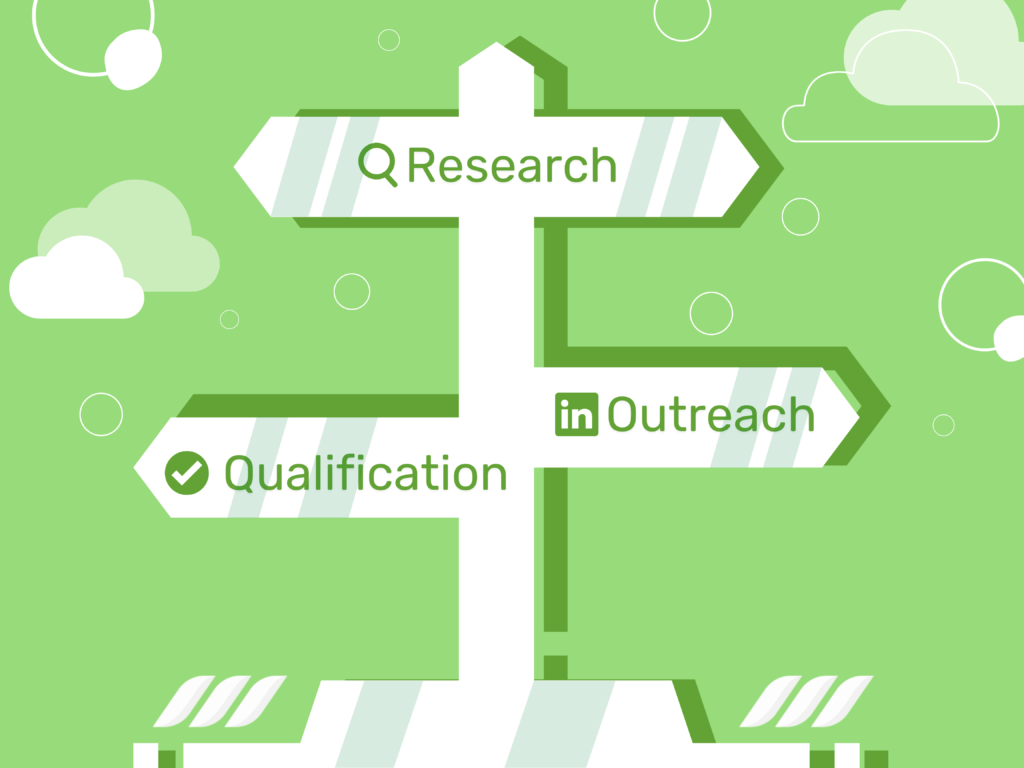
1. Research
The first step of doing lead qualification with Dripify is research. This is where Dripify helps you smartly gather general information about a lead. Dripify gives you an edge by quickly finding the relevant information about a lead and sorting it into an easy-to-understand format.
By providing this valuable information, Dripify lets you identify key decision-makers and craft targeted messages. In addition, Dripify’s research process is completely automated, meaning you can spend more time interacting with leads.
If you’re looking for leads in the software engineering industry, Dripify will help you find their contact information, website, size of the company, and location. With this information, you can quickly decide whether or not a lead is qualified and worth pursuing.
Dripify can also help you keep track of your research to refer to it later. With its easy-to-use interface and powerful search engine, Dripify is an exceptional automation tool for qualifying leads.
2. Outreach
The second step of doing lead qualification with Dripify is outreach, where you approach your leads via cold messaging and study their pattern. Dripify makes cold email drip campaigns a breeze by taking the guesswork out of the equation.
This savvy platform lets you create targeted lists of leads, and its automated system takes care of the rest, ensuring that your messaging is personalized and sent at the right time. As a result, you can focus on your business goals, knowing that your LinkedIn outreach efforts are in good hands.
Automated Outreach via LinkedIn
The Dripify automated LinkedIn outreach tool helps you effortlessly connect with potential leads and gauge their intent. It allows you to set up automatic messages that are sent to your target list of LinkedIn contacts at your preferred time.
The best part? You can customize your LinkedIn outreach messages to include your company name, logo, trackable links, and other marketing add-ons to make converting easier for your lead.
Plus, you can use Dripify to check which contacts have responded to your messages and follow up with them accordingly. Always remember that a follow-up is always critical when dealing with a warm lead. You can automate the follow-up process with Dripify to save time and resources.
Timely follow-ups right from your Dripify dashboard increase your chances of hearing back from your leads. It’s best to keep your messages precise and address their pain points to build a connection.
Drifpify keeps you in touch with potential leads while you sleep. This means you don’t have to manually send messages or make follow-up phone calls. As a result of this automation, you’ll be able to focus on other aspects of your business while still building strong relationships with potential customers.
3. Qualification
The last stage of doing lead qualification with Dripify is checking the qualification indicators of your leads. Qualification indicators help you determine whether a lead is ready to be passed on to sales or if they need more nurturing first.
You can use multiple features at this point, but some common ones include budget, authority, need, and timeline (the BANT framework we explained earlier). Assessing each lead against these criteria will solidify your acquisition goals and ensure that you invest your time in something fruitful.
Here’s what a sales qualified lead will look like:
- Regularly engages with your brand;
- Has a genuine interest in your product or service;
- Has a budget for your product or service;
- Is ready to buy;
- It fits your ideal customer profile;
- It is located in your target market;
- Has the authority to make purchasing decisions.
If you’re looking for qualified leads, keep an eye out for these indicators. You can better convert leads into customers by nurturing leads that show these behavior patterns.
Now, here are the indicators of an unqualified lead that you can push out of your sales cycle and focus on those that can convert:
- Lack of interest/authority;
- Unable to articulate what they want/need;
- Vague about their budget;
- Their project is not a good fit for your company;
- They’re only interested in price, not value;
- You can’t get a hold of them, or they’re unresponsive;
- They have unrealistic expectations or timelines.
If your lead qualification process with Dripify shows these pointers for some leads, you should either remove them from your cycle or design a new strategy for them. Luckily, Dripify lets you send automated messages at intervals that can change your unqualified leads’ perspective. But if this messaging still doesn’t change how your leads respond, it’s time to bid them a farewell.
Conclusion
As any sales professional knows, leads are the lifeblood of any successful business. Without leads, generating new business and growing your company would be impossible. That’s why it’s so important to have a strong lead qualification process in place where you know which leads to remove and which ones to treat with the utmost attention.
Unfortunately, many businesses struggle with lead qualification and jump straight from lead generation to sales presentations. These companies either don’t have a system in place, or their system is ineffective, making them waste their time and resources on useless leads. They end up pursuing unqualified leads and don’t see any conversions.
If you don’t want to see your time and effort go to waste, shake hands with Dripify and start lead qualification right away. Dripify LinkedIn automation tool can help you supercharge your lead qualification process with its advanced mechanism where you see a real-time lead progression. Dripify can quickly and easily identify the most qualified leads, so you can focus your efforts on closing deals. Start your Dripify trial today to learn more about how it can help you grow your business and set it on the path to unprecedented growth.
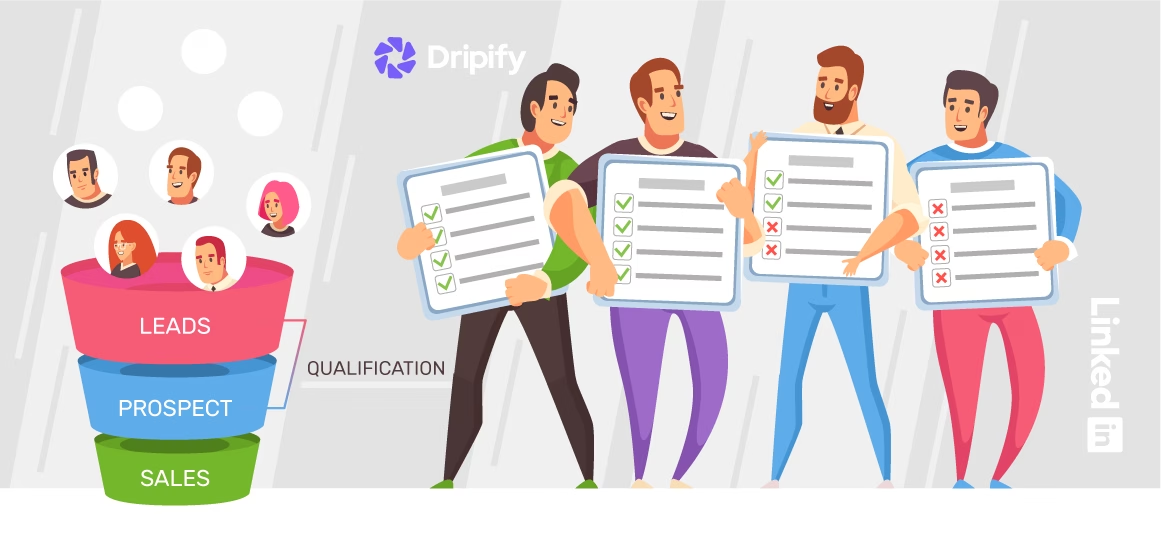
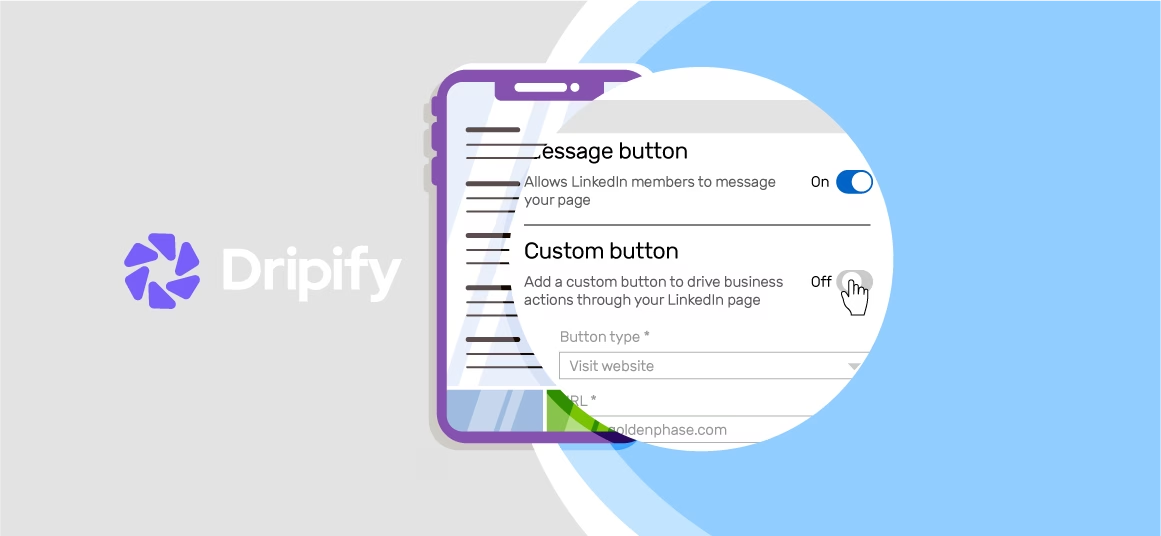
![Email Outreach Tracking [Tips, Tricks and Tools]](https://dripify.io/wp-content/uploads/2025/02/11-7-png.avif)
